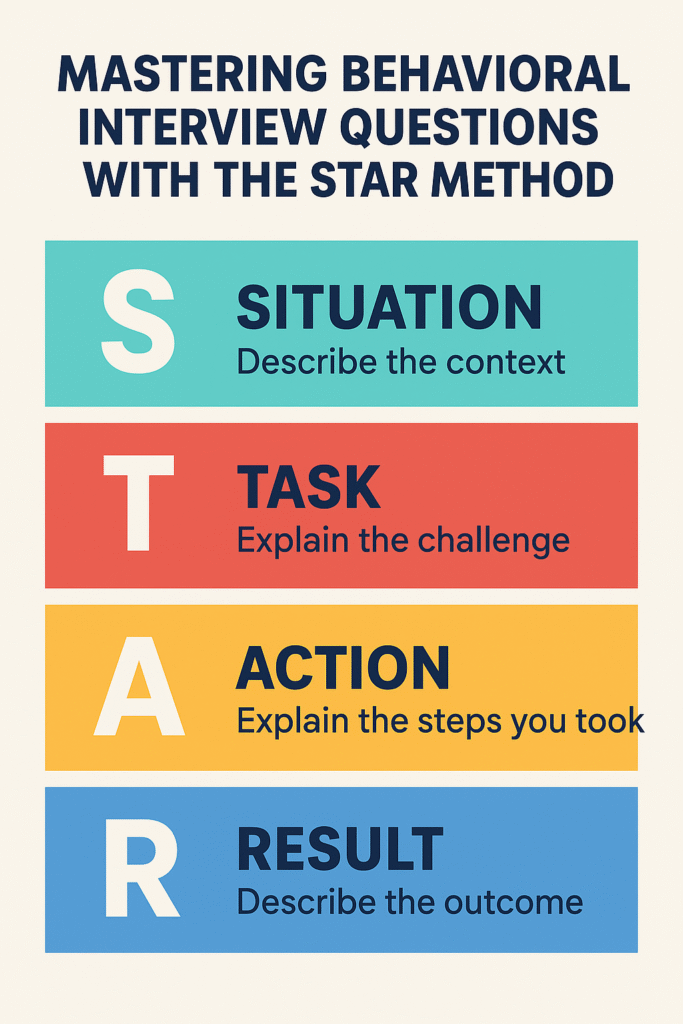Mastering Behavioral Interview Questions with the STAR Method
Introduction
Job interviews aren’t just about your qualifications on paper; they’re about your ability to demonstrate how you think, solve problems, and work with others. That’s why employers often use behavioral interview questions to predict how you’ll handle real-life challenges on the job.
The STAR method (Situation, Task, Action, Result) is one of the most effective ways to answer these questions. It gives you a clear framework, keeps your answers focused, and shows employers exactly how you’ve made a positive impact.
In this guide, we’ll explore what behavioral questions are, how the STAR method works, and examples of STAR-based answers that will make you stand out.

What Are Behavioral Interview Questions?
Behavioral interview questions are designed to assess your past experiences and behaviors in the workplace. Instead of hypothetical scenarios, they focus on what you’ve actually done.
Examples of behavioral interview questions include:
- “Tell me about a time you had to handle a difficult customer.”
- “Describe a situation where you worked as part of a team.”
- “Can you give an example of meeting a tight deadline?”
Employers use these questions because past behavior is often a strong indicator of future performance.
Breaking Down the STAR Method
The STAR method is a simple, four-step technique:
- Situation – Set the scene by describing the context of your story.
- Task – Explain the challenge or responsibility you faced.
- Action – Detail the specific steps you took to address the situation.
- Result – Share the outcome, focusing on your positive impact.
By following this structure, you ensure your answers are organized, compelling, and results-oriented.
How to Use the STAR Method in an Interview
Here’s how you can apply STAR effectively:
1. Listen Carefully
When asked a behavioral question, take a moment to ensure you fully understand it before responding.
2. Choose the Right Example
Pick a relevant story from your past work, internship, or school experience that aligns with the job description.
3. Be Specific
Avoid vague statements. Instead of saying, “I handled it well,” describe exactly what you did.
4. Highlight Results
Employers want to know not just what you did, but the measurable impact. Did you save time, boost sales, improve customer satisfaction, or strengthen teamwork?
Sample STAR Answers
1: “Tell me about a time you had to resolve a conflict at work.”
- Situation: “While working as a customer service rep, I noticed two team members disagreed on how to handle a client request.”
- Task: “As the shift lead, it was my responsibility to ensure the issue was resolved quickly without affecting service quality.”
- Action: “I organized a short meeting, let both employees share their perspectives, and proposed a compromise that followed company guidelines while addressing the client’s needs.”
- Result: “The client was satisfied, both team members felt heard, and productivity improved because the process became clearer for future cases.”
2: “Give an example of meeting a tight deadline.”
- Situation: “During my internship, I was asked to prepare a sales report within 24 hours for an executive meeting.”
- Task: “The challenge was gathering and analyzing large amounts of data under time pressure.”
- Action: “I prioritized key metrics, used Excel automation tools, and collaborated with the finance team to verify numbers quickly.”
- Result: “The report was delivered ahead of schedule, the executives praised its clarity, and it was later used as a template for future reporting.”
3: “Describe a situation where you showed leadership.”
- Situation: “At my previous job, our team was struggling to meet weekly sales targets.”
- Task: “As the most experienced member, I felt responsible to motivate the team and improve performance.”
- Action: “I introduced a daily 10-minute huddle to set goals, share strategies, and recognize achievements.”
- Result: “Within two months, our sales increased by 20%, and team morale significantly improved.”
Why STAR Answers Work
- Shows clarity and confidence.
- Demonstrates problem-solving skills.
- Highlights teamwork and leadership abilities.
- Gives tangible evidence of your value to employers.
Tips for Practicing the STAR Method
- Write down 4–5 strong examples from your experience.
- Practice saying them out loud to stay concise.
- Tailor your examples to the skills listed in the job posting.
- Always keep your answers positive, even if the situation was difficult.
Final Thoughts
Mastering behavioral interview questions with the STAR method gives you a powerful advantage in job interviews. Instead of stumbling through vague answers, you’ll present yourself as a confident, results-driven professional.
Remember: the key is preparation. The more examples you prepare and practice, the easier it will be to adapt your stories to any question. With STAR, you’re not just telling a story, you’re proving to employers that you’re exactly the person they’re looking for.
